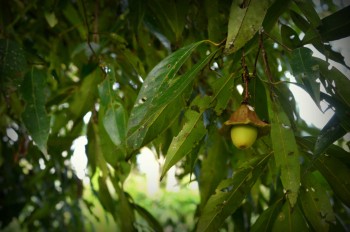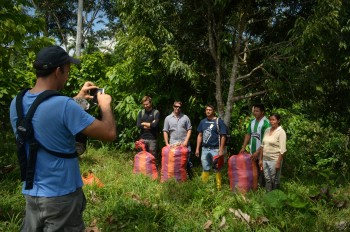Tea of the Amazon: A site visit with the RUNA Foundation
We all know cinnamon – the taste of cookies in december, the decoration on your latte – but who has ever heard of Ecuadorian (or American) cinnamon?
 Like the ‘Azian cinnamon’, that is more common in Europe, the Ecuadorian cinnamon is made of the bark, seeds and leaves of a special tree: the ocotea quitox or ishpingo in Kichwa.
Like the ‘Azian cinnamon’, that is more common in Europe, the Ecuadorian cinnamon is made of the bark, seeds and leaves of a special tree: the ocotea quitox or ishpingo in Kichwa.
This tropical tree grows specifically in Ecuador and Colombia. The tree may not be that known here, but the local communities have used it for centuries and harvest it for its good taste and beneficial effects. On a site visit with local organization RUNA, an NGO supporting communities in the production and trading of tea leaves with the support of the ‘Flemish Tropical Forest Fund’, we can see this closely.
There you are in the Amazon, your feet suffocating in the hot rubber boots, your head between the leaf of a young green tree, and in your nose the smell of Christmas.
RUNA Foundation is committed to the appreciation and sustainable management of tropical forests in the province of Napo, Ecuador, and works closely with the indigenous communities living in and of this area. In the first place, they focus on producers of guayusa, a locally-loved tea made from the leaves of the Guayusa ilex tree. More recently they also started with the production of cinnamon or ishpingo. We followed our partner to Puni Ishpingo, a community a half an hour (and further walking) away of the provincial capital Tena. The main goal of the excursion was to pick up the first harvest of ishpingo, about 150 kilos of leaves for the first experiments with the production of a new tea variant.
Once we arrived at location, the harvest was still in full swing and we immediately got a nice picture of the process. No ishping plantations here, but about eight trees spread across the vastly extended area of a local family.
We were joined by a technician of a processing company, who discusses the terms of purchase. Because both parties can learn a lot about sustainable and profitable production of these tea leaves, so it was important to gather as much data as possible. In addition to the age, care and history of the trees, we learned that ishpingo is not only delicious, but it’s also used for ages by indigenous communities as a medicine for stomach problems.
 A new product also calls for a new approach, so together we investigated the way of harvesting. What percentage of the foliage can be pruned? What is the maximum diameter for twigs and branches? Do you use the pruning shears or just the machete? Compromises were closed as the leaves fell and the bags were filled. The harvest was tasted upon with a solid cup of chicha (a fermented yuca drink).
A new product also calls for a new approach, so together we investigated the way of harvesting. What percentage of the foliage can be pruned? What is the maximum diameter for twigs and branches? Do you use the pruning shears or just the machete? Compromises were closed as the leaves fell and the bags were filled. The harvest was tasted upon with a solid cup of chicha (a fermented yuca drink).
Later that day there was a meeting at the 24 de Mayo community. After a long collaboration on the purchase of guayusa, RUNA now supports this group with its own processing factory. Recently a loan was obtained and the project started off. On the agenda are important matters: from the financial terms for the loan to the planning of the construction process and the application procedure for the company.
This could be the start of a new and sustainable source of income for the 24th of May community. Because in the end, it’s all about creating opportunities.
